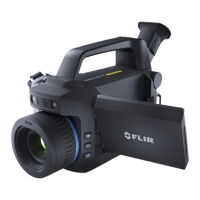Maintenance and cleaning17
CAUTION
• Be careful when you clean the infrared lens. The lens has a delicate anti-reflective coating.
• Do not clean the infrared lens too vigorously. This can damage the anti-reflective coating.
17.2.3 Infrared detector
Even small amounts of dust on the infrared detector can result in major blemishes in the
image. To remove any dust from the detector, follow the procedure below.
Note
• This section only applies to cameras where removing the lens exposes the infrared
detector.
• In some cases the dust cannot be removed by following this procedure: the infrared
detector must be cleaned mechanically. This mechanical cleaning must be carried out
by an authorized service partner.
CAUTION
In Step 2 below, do not use pressurized air from pneumatic air circuits in a workshop, etc., as this air
usually contains oil mist to lubricate pneumatic tools.
Follow this procedure:
1. Remove the lens from the camera.
2. Use pressurized air from a compressed air canister to blow off the dust.
17.3 Cooler maintenance
17.3.1 General
The microcooler is designed to provide maintenance-free operation for many thousands
of hours. The microcooler contains pressurized helium gas.
After several thousand hours of operation the gas pressure decreases, and cooler serv-
ice is required to restore cooler performance. The cooler also contains micro ball bear-
ings, which may exhibit wear by becoming louder.
17.3.2 Signs to watch for
The FLIR Systems microcooler is equipped with a closed-loop speed regulator, which
adjusts the cooler motor speed to regulate the detector temperature.
Typically, the cooler runs at maximum speed for 7–10 minutes (depending on model),
and then slows to about 40% of maximum speed. As the gas pressure degrades, the mo-
tor continues at maximum speed for longer and longer periods to attain operating
temperature
Eventually, as the helium pressure decreases, the motor will lose the ability to achieve
and/or maintain operating temperature. When this occurs, the camera must be returned
to FLIR Systems Customer Service Department for service.
17.4 Camera calibration
• Gas detection: No re-calibration recommendation. The ability to detect gases is not
influenced by the calibration and will not degrade over time.
• Temperature measurement: For applications where infrared cameras are used to
measure temperature, such as in predictive maintenance of electrical or mechanical
assets, we recommend a yearly calibration. With a calibration certificate containing
measurement data, you will be able to track the performance of your camera and de-
cide the most appropriate time to send it in for adjustment.
#T810605; r. AD/92464/92464; en-US
82

